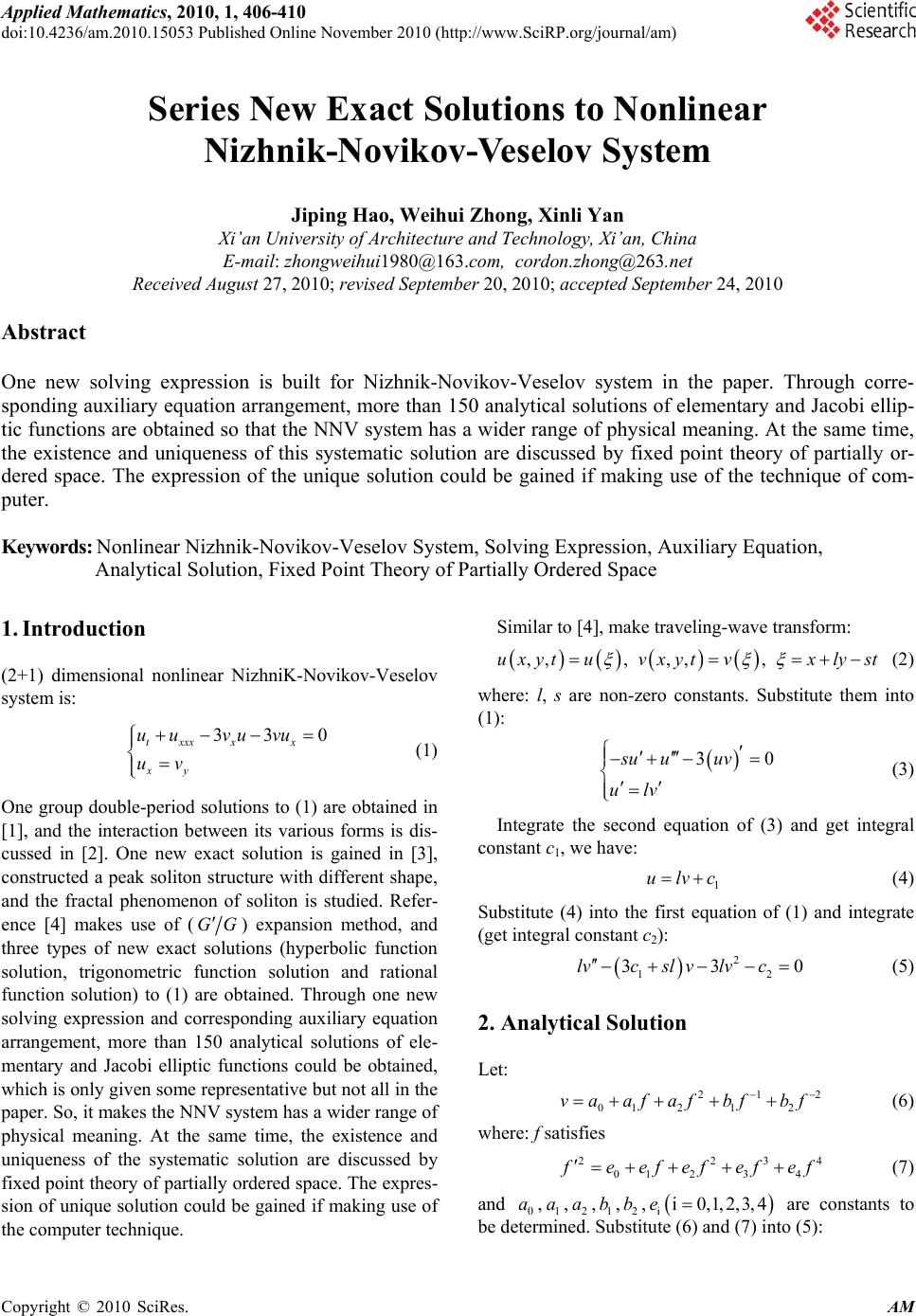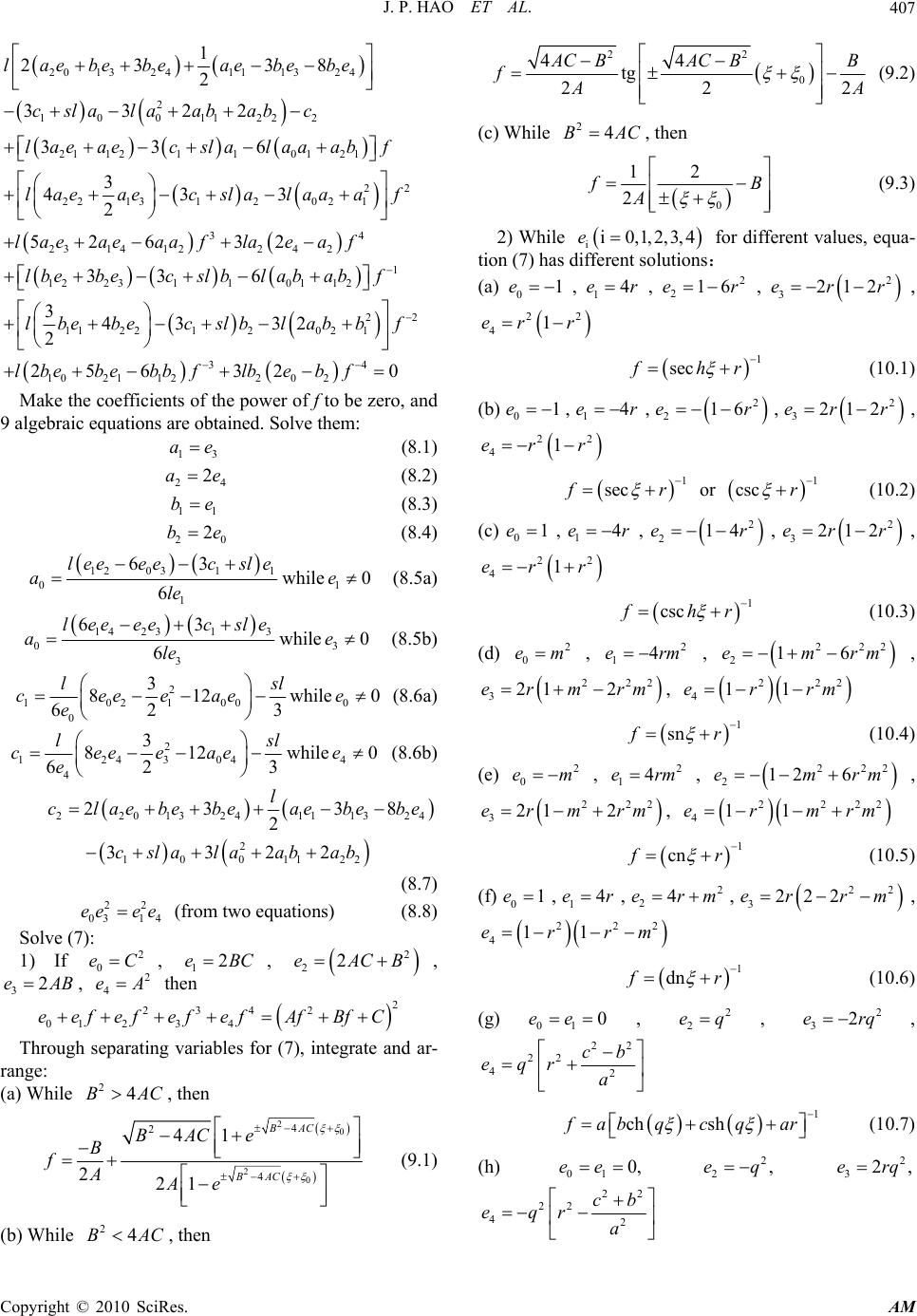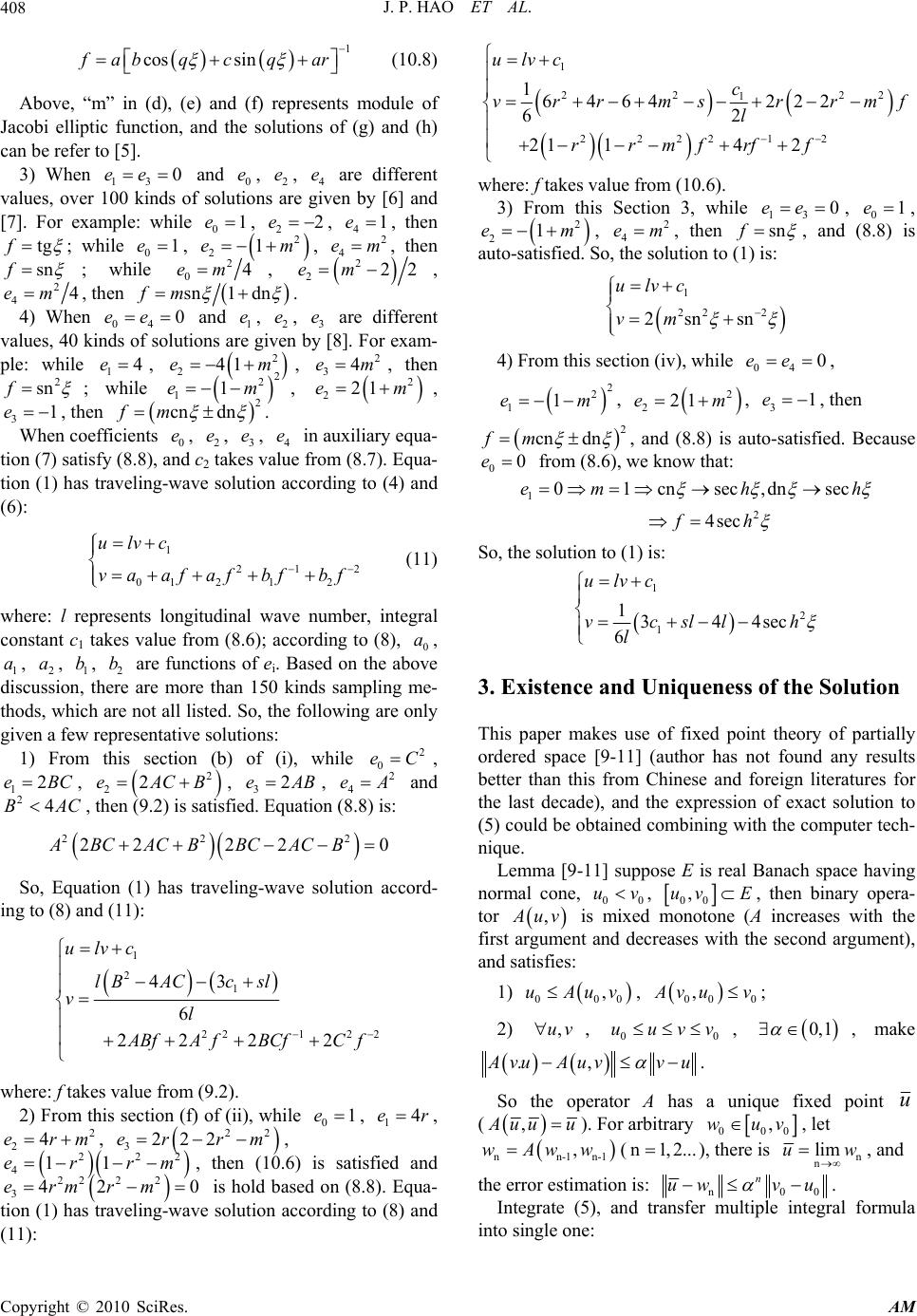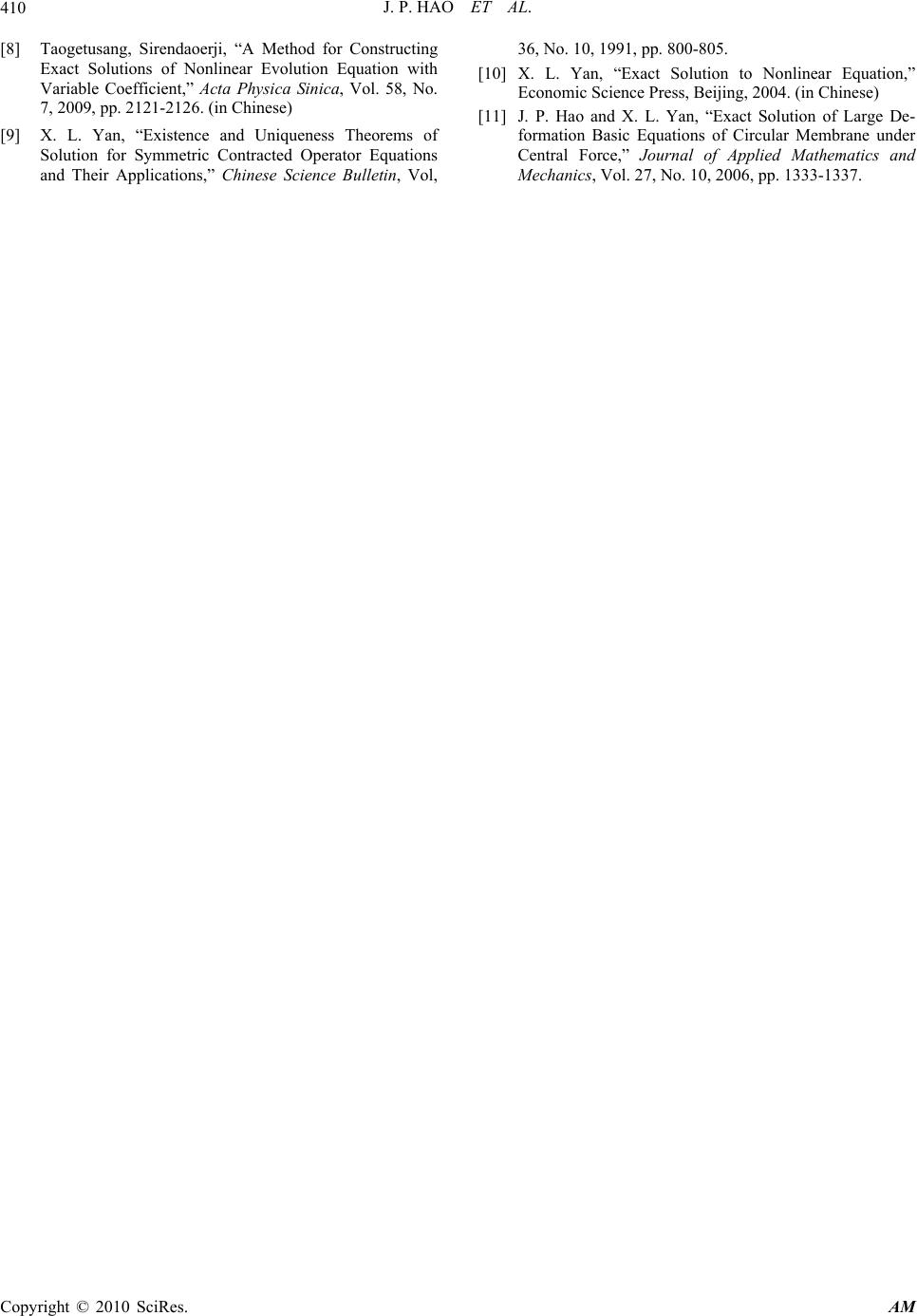Paper Menu >>
Journal Menu >>
 Applied Mathematics, 2010, 1, 406-410 doi:10.4236/am.2010.15053 Published Online November 2010 (http://www.SciRP.org/journal/am) Copyright © 2010 SciRes. AM Series New Exact Solutions to Nonlinear Nizhnik-Novikov-Veselov System Jiping Hao, Weihui Zhong, Xinli Yan Xi’an University of Architecture and Technology, Xi’an, China E-mail: zhongweihui1980@163.com, cordon .zhong@263 .net Received August 27, 2010; revised September 20, 2010; accepted September 24, 2010 Abstract One new solving expression is built for Nizhnik-Novikov-Veselov system in the paper. Through corre- sponding auxiliary equation arrangement, more than 150 analytical solutions of elementary and Jacobi ellip- tic functions are obtained so that the NNV system has a wider range of physical meaning. At the same time, the existence and uniqueness of this systematic solution are discussed by fixed point theory of partially or- dered space. The expression of the unique solution could be gained if making use of the technique of com- puter. Keywords: Nonlinear Nizhnik-Novikov-Veselov System, Solving Expression, Auxiliary Equation, Analytical Solution, Fixed Point Theory of Partially Ordered Space 1. Introduction (2+1) dimensional nonlinear NizhniK-Novikov-Veselov system is: 33 0 txxx xx xy uuvu vu uv (1) One group double-period solutions to (1) are obtained in [1], and the interaction between its various forms is dis- cussed in [2]. One new exact solution is gained in [3], constructed a peak soliton structure with different shape, and the fractal phenomenon of soliton is studied. Refer- ence [4] makes use of (GG ) expansion method, and three types of new exact solutions (hyperbolic function solution, trigonometric function solution and rational function solution) to (1) are obtained. Through one new solving expression and corresponding auxiliary equation arrangement, more than 150 analytical solutions of ele- mentary and Jacobi elliptic functions could be obtained, which is only given some representative but not all in the paper. So, it makes the NNV system has a wider range of physical meaning. At the same time, the existence and uniqueness of the systematic solution are discussed by fixed point theory of partially ordered space. The expres- sion of unique solution could be gained if making use of the computer technique. Similar to [4], make traveling-wave transform: ,,, ,,,uxytuvxytvx lyst (2) where: l, s are non-zero constants. Substitute them into (1): 30su uuv ulv (3) Integrate the second equation of (3) and get integral constant c1, we have: 1 ulvc (4) Substitute (4) into the first equation of (1) and integrate (get integral constant c2): 2 12 330lvcsl vlvc (5) 2. Analytical Solution Let: 212 01 212 va afafbfbf (6) where: f satisfies 2234 01 234 f eefefef ef (7) and 0 a,1 a,2 a,1 b,2 b, ii 0,1,2,3,4e are constants to be determined. Substitute (6) and (7) into (5):  J. P. HAO ET AL. Copyright © 2010 SciRes. AM 407 2 0132 411132 4 1 23 38 2 laebebe aebebe 2 10011222 3322c slalaababc 2112110 121 336lae aec slalaa abf 22 2213120 21 3 433 2 laeaecslalaa af 34 23141224 2 526 32laeaeaaflae af 1 12231101 12 33 6lbebecslblab abf 22 112 2120 21 343 32 2 lbe becslblabb f 34 10211220 2 256 320lbebebbflbebf Make the coefficients of the power of f to be zero, and 9 algebraic equations are obtained. Solve them: 13 ae (8.1) 24 2ae (8.2) 11 be (8.3) 20 2be (8.4) 12 0311 0 1 63 6 leeeec sle ale while 10e (8.5a) 14 2313 0 3 63 6 leeeecsle ale while 30e (8.5b) 2 102100 0 3 812 62 3 lsl ceeeae e while 00e (8.6a) 2 124304 4 3 812 62 3 lsl ceeeae e while 40e (8.6b) 2201324111324 2 1001122 23 38 2 3322 l claebeb eaebeb e cslalaab ab (8.7) 22 031 4 ee ee (from two equations) (8.8) Solve (7): 1) If 2 0 eC, 12eBC, 2 22eACB , 32eAB, 2 4 eA then 2 234 2 01 234 eefefefefAfBfC Through separating variables for (7), integrate and ar- range: (a) While 24BAC, then 20 20 4 2 4 41 221 BAC BAC BACe B fAAe (9.1) (b) While 24BAC, then 22 0 44 tg 222 A CB ACBB f A A (9.2) (c) While 24BAC, then 0 12 2 f B A (9.3) 2) While ii 0,1,2,3,4e for different values, equa- tion (7) has different solutions: (a) 01e ,14er ,2 216er , 2 3212err , 22 41er r 1 sec f hr (10.1) (b) 01e ,14er , 2 216er , 2 3212er r, 22 41er r 1 sec f r or 1 csc r (10.2) (c) 01e ,14er , 2 214er , 2 3212er r , 22 41er r 1 csc f hr (10.3) (d) 2 0 em,2 14erm , 222 216emrm , 222 3212ermrm , 222 411errm 1 sn f r (10.4) (e) 2 0 em ,2 14erm, 222 212 6emrm , 222 3212ermrm , 2222 411ermrm 1 cn f r (10.5) (f) 01e ,14er ,2 24erm , 22 3222er rm, 222 411errm 1 dn f r (10.6) (g) 01 0ee , 2 2 eq, 2 32erq , 22 22 42 cb eqr a 1 ch sh f abqcqar (10.7) (h) 01 0,ee 2 2,eq 2 32,erq 22 22 42 cb eqr a  J. P. HAO ET AL. Copyright © 2010 SciRes. AM 408 1 cos sin f abqc qar (10.8) Above, “m” in (d), (e) and (f) represents module of Jacobi elliptic function, and the solutions of (g) and (h) can be refer to [5]. 3) When 13 0ee and 0 e, 2 e, 4 e are different values, over 100 kinds of solutions are given by [6] and [7]. For example: while 01e , 22e , 41e , then tgf ; while 01e, 2 21em , 2 4 em, then snf ; while 2 04em, 2 222em , 2 44em, then sn1 dnfm . 4) When 04 0ee and 1 e, 2 e, 3 e are different values, 40 kinds of solutions are given by [8]. For exam- ple: while 14e, 2 241em , 2 34em, then 2 snf ; while 2 2 11em , 2 221em, 31e, then 2 cn dnfm . When coefficients 0 e, 2 e, 3 e, 4 e in auxiliary equa- tion (7) satisfy (8.8), and c2 takes value from (8.7). Equa- tion (1) has traveling-wave solution according to (4) and (6): 1 212 01 212 ulvc va afafbfbf (11) where: l represents longitudinal wave number, integral constant c1 takes value from (8.6); according to (8), 0 a, 1 a, 2 a, 1 b, 2 b are functions of ei. Based on the above discussion, there are more than 150 kinds sampling me- thods, which are not all listed. So, the following are only given a few representative solutions: 1) From this section (b) of (i), while 2 0 eC, 12eBC, 2 22eACB, 32eAB, 2 4 eA and 24BAC, then (9.2) is satisfied. Equation (8.8) is: 22 2 22 220ABCAC BBCACB So, Equation (1) has traveling-wave solution accord- ing to (8) and (11): 1 2 1 2212 2 43 6 22 22 ulvc lBACc sl vl A BfAfBCfCf where: f takes value from (9.2). 2) From this section (f) of (ii), while 01e, 14er , 2 24erm, 22 3222er rm, 222 411errm , then (10.6) is satisfied and 22 22 342 0ermrm is hold based on (8.8). Equa- tion (1) has traveling-wave solution according to (8) and (11): 1 22 22 1 2222 12 16464 222 62 21 142 ulvc c vrr msrrmf l rrmfrff where: f takes value from (10.6). 3) From this Section 3, while 13 0ee, 01e , 2 21em , 2 4 em, then snf , and (8.8) is auto-satisfied. So, the solution to (1) is: 1 22 2 2sn sn ulvc vm 4) From this section (iv), while 04 0ee, 2 2 11em , 2 221em, 31e , then 2 cn dnfm , and (8.8) is auto-satisfied. Because 00e from (8.6), we know that: 1 2 01cn sec,dn sec 4sec emh h fh So, the solution to (1) is: 1 2 1 1344sec 6 ulvc vcsllh l 3. Existence and Uniqueness of the Solution This paper makes use of fixed point theory of partially ordered space [9-11] (author has not found any results better than this from Chinese and foreign literatures for the last decade), and the expression of exact solution to (5) could be obtained combining with the computer tech- nique. Lemma [9-11] suppose E is real Banach space having normal cone, 00 uv , 00 ,uv E, then binary opera- tor , A uv is mixed monotone (A increases with the first argument and decreases with the second argument), and satisfies: 1) 000 ,uAuv, 00 0 , A vu v; 2) ,uv , 00 uuvv , 0,1 , make ., A vuAuvvu . So the operator A has a unique fixed point u ( , A uu u ). For arbitrary 000 ,wuv, let nn-1n-1 ,wAww(n1,2... ), there is n n limuw , and the error estimation is: n00 n uwv u . Integrate (5), and transfer multiple integral formula into single one:  J. P. HAO ET AL. Copyright © 2010 SciRes. AM 409 2 1 0 2 234 133vtcslvtlvtdt l ccc (12.1) where: 2 c is different from that in (5) for one factor. If ,0ls and 13csl , let 2 1 0 2 234 1 ,3()3 A uvtcsl vtlutdt l ccc (12.2) then binary operator A increases with u and decreases with v, so A is mixed monotone. Here it makes 0,1EC, because 0,1C is real Banach space hav- ing normal cone. Make the equivalent norm as 01 max Mt t ueut (0,M 0,1 ,ut C 00 ,uv 0,1 ), so 00 2 1234 0 ,0,1 13 Au vA tcsldtccc l 00 2 234 0 ,1,0 13 Av uA ltdtc cc l Make integral constant 1 2 3 2 csl cl , 30c, 423 1 2 ccc , then 000000 0, ,1uAuvAvu v So, operator A defined by (12.1) satisfies the condition (i) of Lemma. 1 0 ,, 133 AvuAuv tlvtut cslvtutdt l 1 0 133 Mt Mt eetlvtutc sl l vtut dt 2 0 ,, 162 Mt Mt Avu Auv eetllcvtutdt l 2 20 23 23 1 Mt M c cvu edtuve M Make 2 23 0, 1 c M , then ,, A vuAuvv u Therefore, the binary operator A defined by (12.1) sat- isfies all conditions of Lemma. Based on Lemma, there is one unique continuous function u for the unique solution to (5) while integral constants 1 c, 2 c, 3 c, 4 c are regular selected. Get 00,1w randomly, let n1n-1n-1 0 2 234 133 1wtcsllwt wtdt l ccc then n n limuw , where 1 c, 2 c, 3 c, 4 c are given their values according to the requirements of this section. 4. Conclusions Accompanied by the corresponding auxiliary equation, this solving expression is built to obtain traveling-wave analytical solution to nonlinear NNV system for the first time. This method for some nonlinear evolution equa- tions is also useful. Some articles solving nonlinear or- dinary differential equation by fixed point theory can often be found in various of mathematical journals. In fact, this theory is also very useful for traveling-wave solution to nonlinear evolution equation. 5. References [1] Y. Chen and Q. Wang, “A Series of New Double Periodic Solutions to a (2+1)-Dimensional Asymmetric Nizhnik- Novikov-Veselov Equation,” Chinese Physics, Vol. 13, No. 11, 2004, pp. 1796-1800. [2] C. Q. Dai and G. Q. Zhou, “Exotic Interactions between Solitons Of the (2+1)-Dimensional Asymmetric Nizhnik- Novikov-Veselov System,” Chinese Physics, Vol. 16, No. 5, 2007, pp. 1201-1208. [3] S. H. Ma, J. P. Fang and Q. B. Ren, “New Mapping Solutions and Localized Structures for the (2+1)- Dimensional Asymmetric Nizhnik-Novikov-Veselov Sys- tem,” Acta Physica Sinica, Vol. 56, No. 12, 2007, pp. 6784-6790. (in Chinese) [4] B. Q. Li and Y. L. Ma, “(G′/G)-Expansion Method and New Exact Solutions for (2+1)-Dimensional Asymme- trical Nizhnik-Novikov-Veselov System,” Acta Physica Sinica, Vol. 58, No. 7, 2009, pp. 4373-4378. (in Chinese) [5] D. C. Lu, B. J. Hong and L. X. Tian, “Explicit and Exact Solutions to the Variable Coefficient Combined KdV Equation with Forced Term,” Acta Physica Sinica, Vol. 55, No. 11, 2006, pp. 5617-5622. (in Chinese) [6] H. M. Li, “Mapping Deformation Method and Its Appli- cation to Nonlinear Equations,” Chinese Physics, Vol. 11, No. 11, 2002, pp. 1111-1114. [7] H. M. Li, “New Exact Solutions of Nonlinear Gross- Pitaevskii Equation with Weak Bias Magnetic and Time- Dependent Laser Fields,” Chinese Physics, Vol. 14, No. 2, 2005, pp. 251-256.  J. P. HAO ET AL. Copyright © 2010 SciRes. AM 410 [8] Taogetusang, Sirendaoerji, “A Method for Constructing Exact Solutions of Nonlinear Evolution Equation with Variable Coefficient,” Acta Physica Sinica, Vol. 58, No. 7, 2009, pp. 2121-2126. (in Chinese) [9] X. L. Yan, “Existence and Uniqueness Theorems of Solution for Symmetric Contracted Operator Equations and Their Applications,” Chinese Science Bulletin, Vol, 36, No. 10, 1991, pp. 800-805. [10] X. L. Yan, “Exact Solution to Nonlinear Equation,” Economic Science Press, Beijing, 2004. (in Chinese) [11] J. P. Hao and X. L. Yan, “Exact Solution of Large De- formation Basic Equations of Circular Membrane under Central Force,” Journal of Applied Mathematics and Mechanics, Vol. 27, No. 10, 2006, pp. 1333-1337. |

